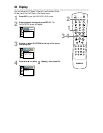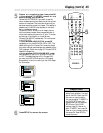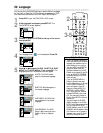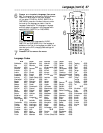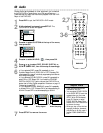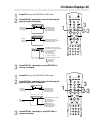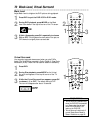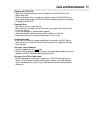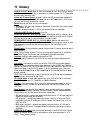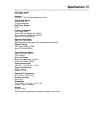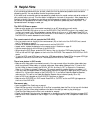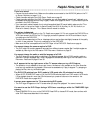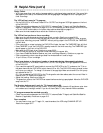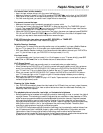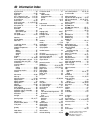
72 Glossary
AUDIO IN/OUT Jacks: jacks on the front and back of the DVD/VCR that receive
audio from another source (IN) or send audio to another system (OUT). These jacks
are red (right) and white (left).
Automatic Channel Setup:
process in which the VCR memorizes all available TV
channels. Then, when you press SKIP i /CHo or SKIP j /CHp in VCR mode,
you only scan through channels you receive.
Bands:
settings that allow you to tune channels.
• Antenna – VHF (very high frequency; channels 2-13) and UHF (ultra high frequen-
cy; channels 14-69).
• Cable – standard channels 1-125 can be received without a Cable Box.
Cable Box/DBS Output Channel:
03 or 04.
COAXIAL DIGITAL AUDIO OUT
jack: Sends digital audio to a Stereo, allow-
ing you to adjust the volume at the Stereo. This connection provides the 5.1 channel
surround sound as heard in movie theaters. This jack is black.
COMPONENT VIDEO OUT (Y,
CR, CB) Jacks: jacks on the back of the
DVD/VCR that send high-quality DVD video to a TV with Component Video In jacks.
This connection provides the best picture quality for the DVD Player of the
DVD/VCR.
Dolby Digital
: A surround sound system that provides 5.1 channel sound as used in
movie theaters.
DTS:
Digital Theater Systems. This is a surround sound system, but it is different
from Dolby Digital. The formats were developed by different companies.
Dubbing:
copying a video cassette using another VCR.
HQ:
high quality; a feature in the VCR circuitry which provides enhanced picture
detail.
Line Input:
The channel to which you set your DVD/VCR during video cassette
copying. If you connected the other video equipment to the AUDIO and VIDEO In
jacks on the front of the DVD/VCR, select L2. If you used the AUDIO and VIDEO IN
jacks on the back of the DVD/VCR, select L1. If you accidentally enter Line Input
mode, press SKIP i /CHo or SKIP j /CHp or the Number buttons to select
another channel.
OTR:
One-Touch Recording; a timed recording on the VCR that starts immediately
and records for 30 minutes to eight hours.
RF coaxial cable:
A black cable supplied with your DVD/VCR. Use it to connect
your DVD/VCR to your TV, Cable Box, or Satellite Receiver.
S-Video:
Produces a clearer DVD picture by sending separate signals for the lumi-
nance and the color. S-Video only provides a picture for the DVD Player of the
DVD/VCR.
Tape Speeds:
how fast the video cassette travels during a recording or playback.
The faster the tape speed, the better the picture quality. Slower tape speeds affect
picture quality, but you can record more onto a videotape.
• SP (standard play) – fastest tape speed (recording time for a T120 tape is approxi-
mately two hours); best picture quality.
• LP (long play) – average tape speed. You cannot record in LP with this VCR. If
tapes were recorded on a different VCR in LP speed, the tape will play in LP on
the DVD/VCR.
• SLP (super long play) – slowest tape speed (recording time for a T120 tape is
approximately six hours). This speed allows the maximum recording on a single
videotape.
VIDEO IN/OUT Jacks:
jacks on the front and back of the DVD/VCR that receive
video from another source (IN) or send video to other video equipment or a TV
(OUT). These jacks are yellow.



